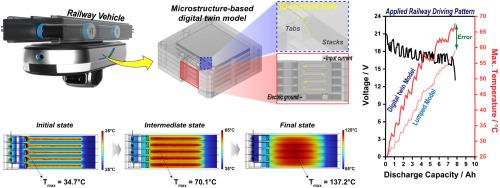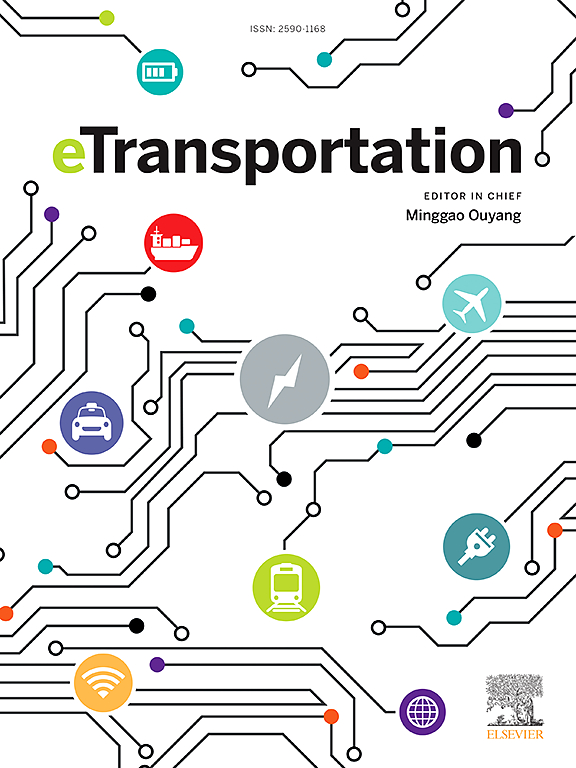基于微观结构的电池到模块级锂离子电池数字孪生热电化学建模
IF 17
1区 工程技术
Q1 ENERGY & FUELS
引用次数: 0
摘要
随着锂离子电池(LIB)的应用范围从传统的电动汽车(EV)扩展到电动卡车或有轨电车等重型车辆,锂离子电池系统中热管理的重要性与日俱增,甚至在模块或电池组层面也是如此。特别是,由于监控每个电池的热行为并不可行,因此模块或电池组级的热电化学建模和模拟对于分析和确保热稳定性至关重要。然而,由于传统的块状热电化学模型无法反映 LIB 电池的实际结构,因此模拟结果与实验结果之间可能存在相当大的差异。为了填补这些空白,我们新开发了一种基于三维微观结构的数字孪生模型,用于无人轨道车辆的电池模块(8.8 Ah/18.5 V,5 个串联的锂电池袋电池)。与传统的块状模型不同,我们的数字孪生模型能准确反映电池的内部结构,并能计算出电池内部每个组件的发热量。因此,与块状模型相反,数字孪生模型不仅能模拟电池内部不均匀的温度梯度,还能估算出电池中可能引发热失控的较高局部最高温度(TDT, max/TL, max = 137.2 °C/123.9 °C @ 10C 放电)。因此,基于微观结构的数字孪生建模可减轻对锂电池、模块和电池组热失控的担忧,并提供安全的运行条件。本文章由计算机程序翻译,如有差异,请以英文原文为准。

Microstructure-based digital twin thermo-electrochemical modeling of LIBs at the cell-to-module scale
As the application of lithium-ion batteries (LIBs) expands beyond conventional electric vehicles (EVs) to heavy vehicles such as electric trucks or trams, the importance of thermal management in LIB systems is increasing, even at the module or pack level. In particular, because monitoring the thermal behaviors of each cell is not feasible, thermo-electrochemical modeling and simulations in the module or pack level are essential for analyzing and ensuring thermal stability. However, because the conventional lumped thermo-electrochemical models cannot reflect the actual structure of LIB cells, there might be considerable differences may exist between simulation and experimental results. To fill these gaps, we have newly developed a 3D microstructure-based digital twin model of a battery module (8.8 Ah/18.5 V, five LIB pouch cells in series) for an unmanned railway vehicle. Unlike traditional lumped models, our digital twin model accurately well reflects the internal structure of cells and can calculate the heat generation of each component inside a cell. As a result, contrary to a lumped model, the digital twin model can not only simulate the inhomogeneous temperature gradient inside a cell, but also estimates higher local maximum temperatures (TDT, max/TL, max = 137.2 °C/123.9 °C @ 10C discharge) in cells which can trigger thermal runaway. Therefore, microstructure-based digital twin modeling can alleviate concerns regarding the thermal runaway of LIB cells, modules, and packs, and provide safe operating conditions.
求助全文
通过发布文献求助,成功后即可免费获取论文全文。
去求助
来源期刊

Etransportation
Engineering-Automotive Engineering
CiteScore
19.80
自引率
12.60%
发文量
57
审稿时长
39 days
期刊介绍:
eTransportation is a scholarly journal that aims to advance knowledge in the field of electric transportation. It focuses on all modes of transportation that utilize electricity as their primary source of energy, including electric vehicles, trains, ships, and aircraft. The journal covers all stages of research, development, and testing of new technologies, systems, and devices related to electrical transportation.
The journal welcomes the use of simulation and analysis tools at the system, transport, or device level. Its primary emphasis is on the study of the electrical and electronic aspects of transportation systems. However, it also considers research on mechanical parts or subsystems of vehicles if there is a clear interaction with electrical or electronic equipment.
Please note that this journal excludes other aspects such as sociological, political, regulatory, or environmental factors from its scope.
 求助内容:
求助内容: 应助结果提醒方式:
应助结果提醒方式:


